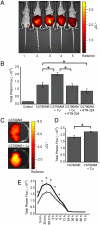Near-infrared fluorescent sensor for in vivo copper imaging in a murine Wilson disease model
- PMID: 22308360
- PMCID: PMC3289337
- DOI: 10.1073/pnas.1113729109
Near-infrared fluorescent sensor for in vivo copper imaging in a murine Wilson disease model
Abstract
Copper is an essential metal nutrient that is tightly regulated in the body because loss of its homeostasis is connected to severe diseases such as Menkes and Wilson diseases, Alzheimer's disease, prion disorders, and amyotrophic lateral sclerosis. The complex relationships between copper status and various stages of health and disease remain challenging to elucidate, in part due to a lack of methods for monitoring dynamic changes in copper pools in whole living organisms. Here we present the synthesis, spectroscopy, and in vivo imaging applications of Coppersensor 790, a first-generation fluorescent sensor for visualizing labile copper pools in living animals. Coppersensor 790 combines a near-infrared emitting cyanine dye with a sulfur-rich receptor to provide a selective and sensitive turn-on response to copper. This probe is capable of monitoring fluctuations in exchangeable copper stores in living cells and mice under basal conditions, as well as in situations of copper overload or deficiency. Moreover, we demonstrate the utility of this unique chemical tool to detect aberrant increases in labile copper levels in a murine model of Wilson disease, a genetic disorder that is characterized by accumulation of excess copper. The ability to monitor real-time copper fluxes in living animals offers potentially rich opportunities to examine copper physiology in health and disease.
Conflict of interest statement
The authors declare no conflict of interest.
Figures





References
-
- Lippard S, Berg JM. Principles of Bioinorganic Chemistry. Mill Valley, CA: University Science Books; 1994.
-
- Gray H, Stiefel EI, Valentine JS, Bertini I. Biological Inorganic Chemistry: Structure and Reactivity. Mill Valley, CA: University Science Books; 2007.
-
- Prohaska J, Gybina AA. Intracellular copper transport in mammals. J Nutr. 2004;134:1003–1006. - PubMed
-
- Que E, Domaille DW, Chang CJ. Metals in neurobiology: Probing their chemistry and biology with molecular imaging. Chem Rev. 2008;108:1517–1549. - PubMed
Publication types
MeSH terms
Substances
Grants and funding
LinkOut - more resources
Full Text Sources
Other Literature Sources
Medical
Molecular Biology Databases

